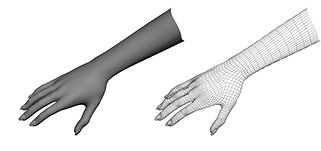AFFECTIVE COMPUTING
Mapping a model to detect and analyse gesture
To be able to detect emotion from gesture, the user's movement has to be analysed and match to a common set of data in the database. These models can be mapped in both 3D and 2D depending on the level of detail the system demands
3D model-based mapping
Volumetric-based algorithm
This algorithm has the highest level of precision and is commonly used in graphics and animation areas. The surface of the subject is mapped onto a 3D-mesh model (see Figure 1). However due to the detailed results the method is very computationally intensive and is not yet practical for live gesture analysis.
Figure 1 : 3D mesh model mapping
Figure 2: replacing main body parts
with simple objects
In Figure 2, simple objects like cylinders and spheres are used to approximate
body parts. While dropping fine details of the model and focusing more on
important parts of the body, the time and intensity of processing is reduced.
Skeletal-based algorithm
A less intensive method is to simplify joints and angle of
body parts into an uncomplicated model. Most analysis is done
on the orientation and location of each part. Here we only
compute key parameters so the whole analysis is faster than
volumetric and matching with template from database can
be done more easily.
Figure 3: skelatal-based mapping
Simple markers mapping
Another practical method is to use 'markers' attached to different body parts of the subject and cameras to capture these points and map them onto a 3D- space. The path of each points can then be recorded over a period of time. This ignores most of the details and only focus on main joints of the body. This is also known as the VICON motion capture system.
Figure 4: VICON motion capture system
2D view-based mapping
This method extracts input from the camera(s) and outline them
into a 2D figure. This is mostly used in multimodal emotion
recognition to minimise the processing time and intensity so
other methods regarding facial expression and speech can be carry
out. The subject is observed in environment that their body
parts stand out e.g. bright-coloured rooms and wearing bright
coloured shirts.
Figure 5: 2D based model
Matching with Database
Subjects can enact basic emotions to be recorded in order to construct the templates ot database for comparison and detection. In order to get expressive gestures professional dancers are used in some experiments. The features extracted from the movements are mainly the cartesian coordinates of focus points in (x,y,z) for 3D space and (x,y) for 2D, the velocity of the points, and the acceleration. The common features each emotion share can then be stored as the base data collection. The detection system can be implemented in a way that it can also improve database upon machine learning.




